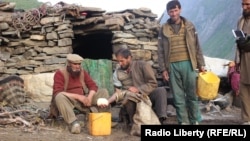ASADABAD, Afghanistan – Rising insecurity has prompted hundreds of families to flee their homes in remote parts of a mountainous province in eastern Afghanistan this week.
Thousands of civilians have fled their homes in several districts of eastern Nuristan Province. Most are seeking shelter in the provincial capital, Parun, while some have fled into the neighboring provinces of Kunar and Nangarhar.
Civilians displaced in Nuristan say frequent clashes between government forces and the insurgents and infighting between the Taliban and Islamic State (IS) militants have made it difficult to stay in their mountain hamlets where most live off the forests, subsistence farming, or animal husbandry.
Some among the displaced say they were forced to leave because of their support for the government.
Maulavi Ziaur Rahman, a former governor of Nuristan’s Wanat Waygal district, says he fled the region after the insurgents burned down his house because of his loyalties to the government.
“They burned down my house along with all our belongings and even the religious books,” he told Radio Free Afghanistan. “They also took away all our goats and cows. Now we are left with nothing.”
Maulvi Najibullah, another displaced civilian, says that despite being forced to abandon their homes in the name of supporting the government, the authorities have extended little help.
“We get only a fraction of the aid that is being sent here for the displaced,” he told Radio Free Afghanistan. “Some people have received food staples and utensils, but no one has received the cash grants we were supposed to get.”
But Nuristan Governor Hafiz Abdul Qayum says local authorities have efficiently distributed whatever aid they received from various government ministers for the displaced.
“We recently distributed some 60 kilograms of food aid and some nonfood items to every displaced family,” he said. “But our government cannot cover all their expenses because it is beyond our means.”
The Geneva-based Internal Displacement Monitoring Center says that some 319,000 people were displaced across Afghanistan during the first six months of the current year. Most of them were displaced by fighting while natural disasters forced 106,000 people to flee their homes. The center estimates that overall more than 2.5 million Afghans remain internally displaced.
Displacement has been a constant feature of more than four decades of war in Afghanistan. The war has turned Afghans into one of the largest refugee communities in recent history by forcing an estimated 10 million people to seek shelter in neighboring countries and around the world.
Abubakar Siddique wrote this story based on Rohullah Anwari’s reporting from Asadabad, Afghanistan.
